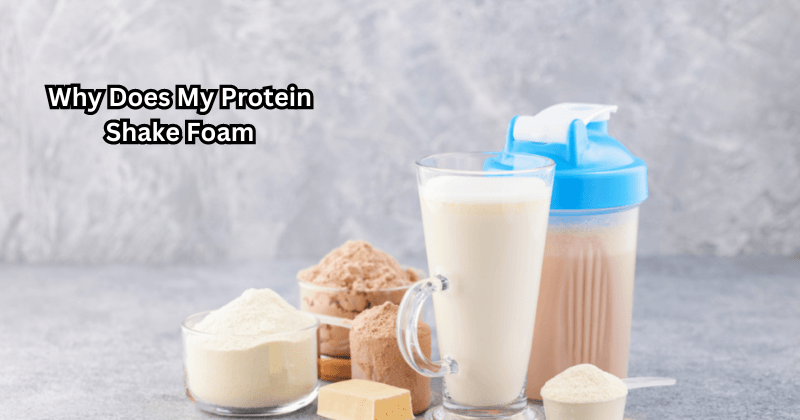Understanding why your protein shake foams is essential for optimizing their texture and taste. The presence of foam in a protein shake can be influenced by various factors, such as the ingredients used, the blending technique, and even the temperature of the liquid.
This introduction will delve into the science behind foam formation in protein shakes, explore common reasons why your shake may be foamy, and provide practical tips to minimize or enhance foam based on your preferences.
By gaining insights into the foaming phenomenon, you can elevate your protein shake experience and enjoy a smoother, more satisfying drink with each blend.
The Science Behind Foam Formation
Foam in a protein shake is created by trapping air bubbles within the liquid. This process, also known as bubble entrapment, occurs when proteins are denatured and form a network of interconnected strands that can hold air pockets.
Agitation, such as blending or shaking, typically causes proteins to denaturate. This disrupts the bonds between protein molecules and allows them to unfold and connect.
As more air is introduced into the mixture, the foam becomes thicker and more stable. Whey protein shake, in particular, is known for its ability to create foamy drinks due to its high concentration of whey protein and its unique molecular structure.
Should I Drink the Foam in My Protein Shake?
The foam in a protein shake is safe to consume and can provide additional nutritional benefits. The air bubbles trapped in the foam contain oxygen, which helps improve blood flow and promote healthy digestion. Additionally, some studies suggest that consuming whey protein in its foamy form may lead to better absorption and utilization of amino acids.
However, if you prefer a smoother texture or do not enjoy the taste of foam, there are ways to minimize or remove it from your shake. Additionally, whey protein shakes may produce a thicker and more stable foam compared to other types of protein powders, such as casein or soy.
Reasons Why Does My Protein Shake Foam
Now that we understand the science behind foam formation, let's explore some common reasons why your protein shake may be foamy:
- Too much agitation: As mentioned before, blending or shaking the protein shake too vigorously can create excessive foam. This affects protein shakes with high fat or sugar content and whey protein shakes.
- Low-grade protein powder: Cheaper protein powders may contain lower-quality proteins more prone to foaming. Consider investing in a higher-quality powder for a smoother drink.
- High concentration of whey: While whey is a popular choice for its amino acid profile and foamability, using too much of it in your shake can result in excessive foam. Whey protein concentrate, in particular, is more likely to produce foam than whey isolates. Whey protein foam can also be influenced by pH, temperature, and fat content.
- Inadequate liquid volume: Not adding enough liquid to the mixture can cause the shake to become too thick, resulting in increased foam formation.
- Using carbonated liquids: Carbonation can create even more foam in a protein shake, so avoiding using sparkling water or soda when making your drink is best.
By understanding these factors, you can troubleshoot foam issues in your protein shake and make adjustments to create the perfect consistency for your taste preferences. Protein supplements offer a convenient and versatile way to increase your protein intake, and by managing foam formation, you can optimize your shake experience.
Tips for Controlling Foam in Your Protein Shake
To minimize or enhance foam in your protein shake, here are some practical tips to keep in mind:
Add ingredients gradually:
When blending a protein shake, add the liquid first, followed by the powder and other ingredients. This will reduce the air incorporated into the mixture and lessen foam formation.
Avoid over-blending:
Over-blending can introduce too much air into the shake, producing excessive foam. Blend until all ingredients are fully incorporated and stop before large air bubbles form.
Chill the liquid:
Cold liquids tend to create less foam than room-temperature ones. Try using chilled water or milk in your protein shake to minimize foam. To minimize foam formation, it is recommended to mix whey protein powder with water, milk, or a blend of the two.
Use a blender ball:
If you are using a shaker bottle, adding a stainless steel blender ball can help break down foam bubbles and create a smoother drink with minimal foam.
Let it sit:
Allowing your protein shake to sit for a few minutes after blending can help the foam settle and reduce its volume. But keep in mind that this may also result in a thicker consistency.
Strain the foam:
If you prefer a smooth drink, strain the foam by pouring your shake through a fine-mesh sieve or cheesecloth. So, foaming or frothing doesn't affect protein shakes in terms of nutritional value and safety. It is simply a matter of personal preference.
So, when mixing whey protein shakes, remember that some foam formation is normal and can even provide health benefits. By understanding the science behind foam formation and implementing these tips, you can control the amount of foam in your protein shake to achieve your desired texture and taste.
Is Foaming Good or Bad in Whey Protein?
When mixing whey protein powder into a drink, some foaming is expected and can be beneficial. The amount of foam depends on personal preference, with some individuals enjoying thick, frothy shakes while others prefer a smoother texture.
Ultimately, whether foam in whey protein is good or bad comes down to individual taste preferences and the desired consistency of your shake. By understanding the underlying factors that contribute to foam formation and using practical tips to control it, you can create the perfect protein shake for your liking. Additionally, consuming the foam in your protein shake is safe and may offer some health benefits, making it a win-win situation for all. So go ahead and enjoy that foamy protein shake guilt-free.
FAQs
Why do proteins form foam?
Proteins, particularly those found in whey protein powder, have the ability to create foam due to their molecular structure. When mixed with liquid and agitated, air is incorporated into the mixture, resulting in the formation of bubbles and a foamy texture.
What ingredient causes foaming?
The main ingredient in protein powder that contributes to foam formation is whey protein. Other factors such as agitation, fat content, temperature, and pH can also influence the amount of foam in a protein shake.
Is it safe to consume the foam in my protein shake?
Unless you have an intolerance or allergy to any ingredients in your protein shake, consuming the foam is generally considered safe and may offer some health benefits. However, if you prefer a smooth texture or do not enjoy the taste of foam, there are ways to minimize or remove it from your shake.
What chemical stops foaming?
There are several chemicals that can be used to control foam, such as surfactants and antifoaming agents. However, these are typically not present in protein shakes and are more commonly used in industrial processes or food production.
Conclusion
In conclusion, the foaming of protein shakes is a natural occurrence influenced by several factors such as protein type, blending intensity, liquid temperature, and the presence of air during mixing. While some foam can enhance mouthfeel and visual appeal, excessive foam may affect overall satisfaction.
By understanding the science behind foam formation and experimenting with different ingredients and preparation methods, you can control and adjust the level of foam in your protein shake to suit your preferences. Whether aiming for a frothy treat or a smoother texture, mastering the art of managing foam adds a personalized touch to your protein shake experience.


